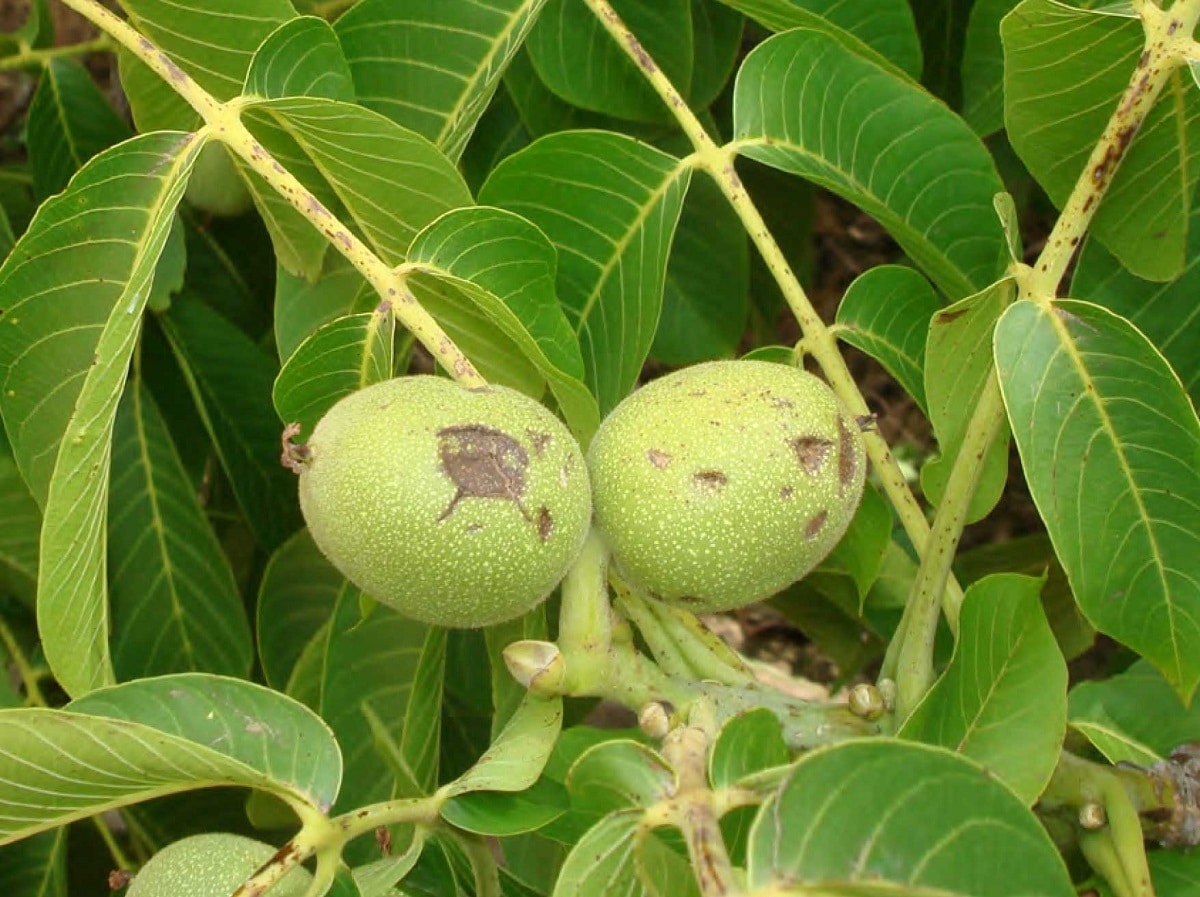

The walnut is a vigorous tree over 25 meters tall with a wide crown and a trunk diameter of up to 3 to 4 meters. There are many varieties of walnut plants, and while many are resistant to pests, one of the most damaging diseases is anthracnose. You have to know how to treat walnut anthracnose in order to reduce impacts to the tree.
In this article we are going to tell you what are the different steps to learn how to identify walnut anthracnose, what are its characteristics and how to combat it.
Walnut characteristics


The walnut tree is deciduous, which means that it loses most of its leaves at certain times of the year. It has a wingspan of up to 30 meters in height and a massive trunk up to 2 meters in diameter. The trunk is short and white, sometimes grey. Powerful branches grow from it, forming a large, voluminous and round crown.
The leaves of the walnut they are large, about 25 cm long, supported by petioles about 5 to 8 cm long. These leaves are dark green in color and alternate in abundance on the branches. The flowers are also light green. Males are weeping willows, females are solitary tangs.
The fruits that we commonly call nuts will be born from the female flowers, although botanically they are not, but rather drupes, with an endocarp formed by a stony and corrugated component inside which is an edible and highly appreciated seed.
What is walnut anthracnose


Walnut anthracnose (Gnomonia leptostyla) is a fungal disease caused by fungi of the genera Colletotrichum, Gloesporium, and Coniothyrium. The disease occurs on roots, leaves, and walnut fruits when there is excess moisture and low temperatures.. All varieties of walnuts are susceptible to this disease, but its severity generally depends on the stage of emergence.
Therefore, the youngest walnut plants are usually the most affected by anthracnose. It is important for farmers to identify walnut anthracnose and the type of fungus that causes it. Good information and knowledge about the disease can help restore nut crops. A severe infestation of anthracnose can result in the total loss of the crop.
What are the symptoms?
Walnut anthracnose causes intense defoliation that begins to weaken the entire plant in a very profound way. Affected leaves develop many small, round, brown spots characterized by a whitish halo underneath, which can distinguish them from bacterial diseases.
In addition, in the walnut leaves that fall to the ground in winter, perithecia (ascocarp structures) with asci and ascospores are formed. In fruits, anthracnose causes deformations, which affect the seeds, and spots that group and enlarge are observed. During periods of vegetative cessation of walnut trees, it also suffers from anthracnose on its lignified branches, which appear as if the bark is scaly and has a gray tinge.
Walnut anthracnose is associated with temperatures close to 20ºC and very high relative humidity.. One of the strangest symptoms of walnut anthracnose is the spots produced by the fungus that cannot penetrate the veins of the leaves, especially if they are large.
How to Control Walnut Anthracnose


Walnut anthracnose is a very serious problem for farmers because it can affect the entire plant and cause significant economic losses. When the fruits are stained with anthracnose, they cannot be sold. If the plant gets carried away with the disease, it will simply destroy the crop completely. That is why it is important to take measures to control and combat anthracnose from the moment of planting, as the plants develop and grow.
The method of treatment and control of walnut anthracnose is through preventive cultivation techniques and finally through appropriate chemical measures against the disease.
Walnut Anthracnose Treatments
The treatments for the control of anthrax are products with copper as an active principle:
- copper hydroxide
- Copper oxychloride
- Bordeaux broth
Experts recommend dealing with some type of moisturizer to keep the product on the sheets for at least 48 hours. During treatment, if it rains suddenly, it is necessary to start from the very beginning and repeat the procedure as soon as possible.
After the second treatment with copper, it is recommended to add some fungal products to improve the health of the plantation. The treatment must be carried out in three stages according to the phenology of the species:
- The first to overflow
- The second when the female flowers are in bloom
- The third is during fruit set
If from the beginning of the treatment it is observed that it is a rainy year, it should be re-treated every 15 days. It is also recommended to burn the fallen leaves and fruits of the trees, since the fungus remains active during the winter. During the growth of the plant, in case the nuts are damaged by hail, it is important to use a systemic fungicide such as difenoconazole.
How to prevent it
Walnut anthracnose can be prevented with phytosanitary and cultural measures, in which the following points can be highlighted:
- Sow varieties that are less susceptible to disease attack and their seeds are the product of healthy and vigorous specimens.
- Choose materials that are certified free of hazardous substances for planting or planting.
- Rotate crops and use appropriate crops to avoid the presence of anthracnose.
- Use a balanced fertilization method, soil amendments, watering, and proper drainage.
- Carry out deep and regular pruning to eliminate the affected parts of the walnut tree and combat any source of disease.
- Prune walnut plants and remove weeds to prevent the development and spread of the fungus.
- Maintaining the right temperature and crop irrigation systems, avoiding excess water and high humidity are essential elements for the appearance of anthracnose.
I hope that with this information you can learn more about walnut anthracnose and its characteristics.
